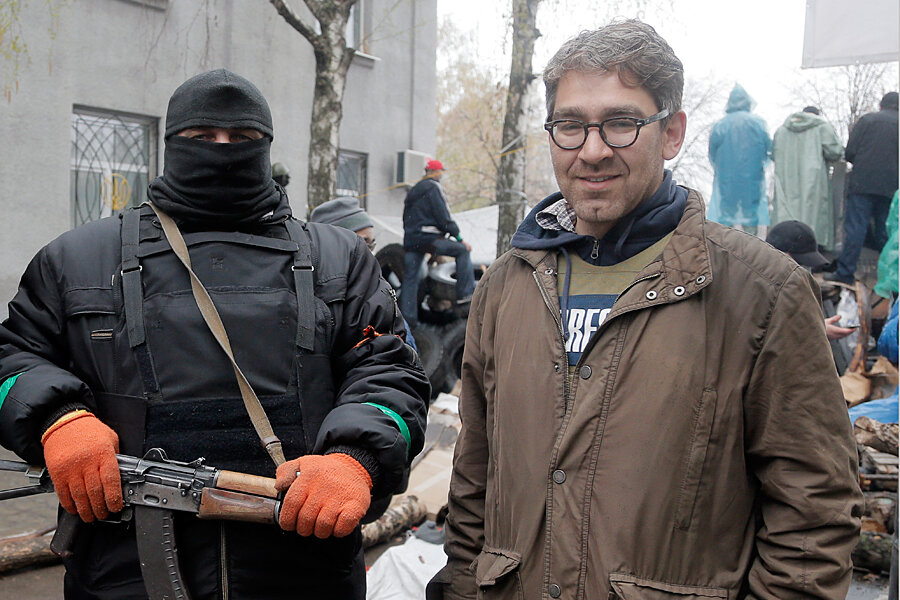What Simon Ostrovsky's detention means for Ukraine's information wars
Loading...
After being locked up by pro-Russia separatists in the eastern Ukrainian city of Slovyansk, American journalist Simon Ostrovsky was "safely released" on Thursday evening, culminating four days of confusion and conflicting accusations that underscore a dark new reality for reporters in eastern Ukrainian turmoil.
Perhaps it is not surprising that Mr. Ostrovsky, the American journalist grabbed by pro-Russia militiamen in the Ukrainian city of Slovyansk on Monday, was one of the first journalists to be apparently targeted in the restive region.
The reporter for Brooklyn-based media organization Vice News has been crisscrossing the country since March, documenting his travels with widely watched gonzo-style video dispatches titled “Russian Roulette.” Pro-Russia separatists in Slovyansk confirmed on Wednesday that they had jailed him.
But the kidnapping of Ostrovsky, along with at least three other journalists detained or gone missing in eastern Ukraine in recent days, appears to mark a new, if predictable low in the information war waged between Moscow and Kiev. As the crisis as Ukraine has rolled on, Western journalists have increasingly been viewed by those in the east as "provocateurs" attempting to further Kiev's goals and destabilize the Russia-leaning regions.
Ostrovsky was abducted shortly after attending what he called the “world’s weirdest press conference” with the town’s leading pro-Russian activist and self-styled “citizen mayor,” Vyacheslav Ponomarev.
Two days later, Mr. Ponomaryov, told Interfax that Ostrovsky was arrested by the region’s “self-defense” forces because he was suspected of being a spy for the Right Sector, a radical right-wing group that took part in the Maidan movement.
Four other correspondents were briefly detained together with Ostrovsky on Monday; they were let go while he was kept behind.
Moscow's vision of reality in eastern Ukraine, deeply absorbed by the separatists, is that the region's pro-Russian citizens are under assault by Kiev, now controlled by radical Ukrainian nationalists. The West is in cahoots with Kiev, this view holds, stirring the turmoil in Ukraine to destabilize the region (and weaken Russia). And Western journalists, by extension, are agents of this pact, their coverage of the crisis the engine of the conspiracy.
As a result, journalists reporting for outlets in the West, and even in Kiev, have increasingly been facing suspicion and hostility in the insurgent regions. The act of covering the takeover of a military base, or a confrontation between Ukrainian soldiers and militiamen, has come to be seen as more than a fact-finding exercise. It's now viewed as a "provocation" playing into the perceived enemy's hand.
The second accusation against Ostrovsky was that he was being held for "improper work," a possible hint that his arrest was to serve as a warning of sorts to others.
It may have been one of Ostrovsky's 28 dispatches that spurred the pro-Russia camp to react. The collection, full of biting commentary, uncomfortable questions, and go-for-broke heroics, have likely raised a few hackles. The videos have been viewed hundreds of thousands of times.
In one early video, filmed as the Russian takeover of Crimea was nearing completion, Ostrovsky clambers over the concrete wall of a Ukrainian naval base, under siege by crowds chanting pro-Russia slogans, to interview officers who had barricaded the doors with furniture and braced for the inevitable eviction. Once the team venture back outside, the crowd rushes the Vice team, grabbing the cameraman by the neck and forcing them to turn off their camera – in what was to become a scene repeated from one segment to another.
A more recent dispatch shows a standoff between pro-Russian activists and a group of Ukrainian soldiers near Slovyansk. The soldiers were ordered to ride tanks toward the city, but gun-wielding men in camouflage uniforms quickly stopped and disarmed them. Separatists have claimed that all such fighters belong to local grassroots self-defense groups, and that any similarities with how things went down in Crimea are accidental.
"Are you from Crimea?" Ostrovsky asks one such militiaman.
"Yes," the man responds, adding that "there are five, maybe six more people from Crimea" among the group, along with fighters from other eastern Ukrainian regions.
And last week, Ostrovsky reported from inside a riotous crowd – literally – as it stormed a police building in the town of Horlivka, breaking windows and beating a police officer who refused to cross to their side. "This is not a genius move on my part," he says into the camera from the tear-gas-filled room over the sound of shattering glass. "This is what the pro-Russian revolution in eastern Ukraine looks like from the inside."








